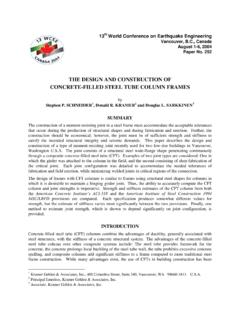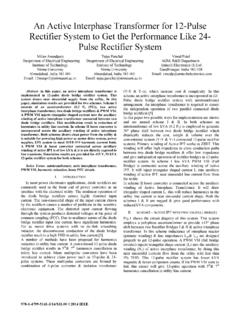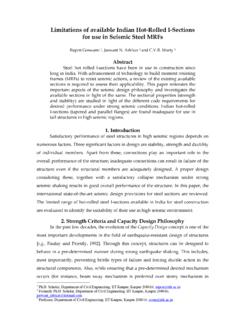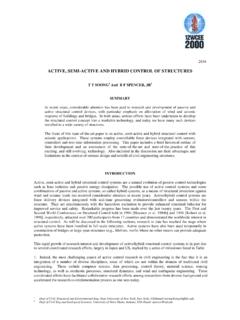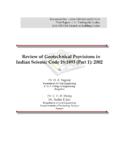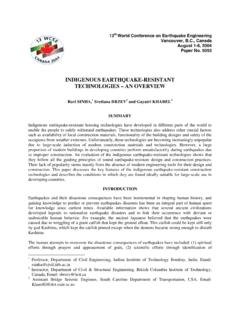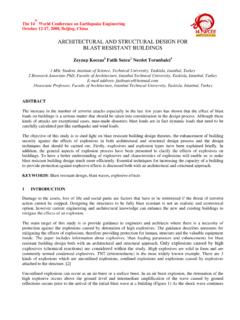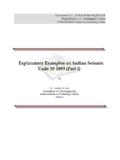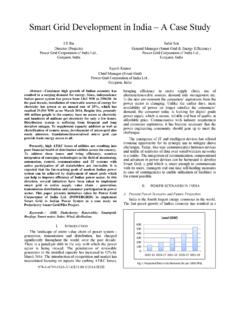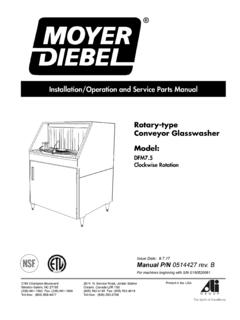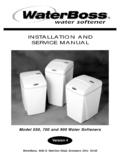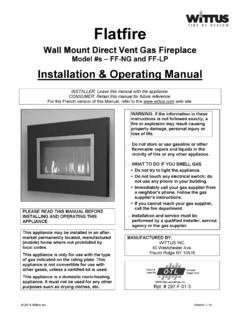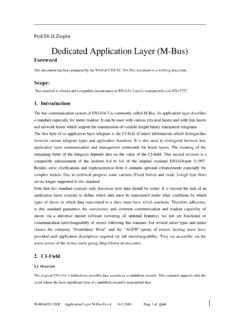Transcription of Document No. :: IITK-GSDMA-Wind05-V1.0 Final …
1 Document No. :: Final Report :: B - Wind Codes IITK- gsdma Project on Building Codes IS:875 (Part 3) - 1987. A Commentary on Indian Standard code of practice for design loads (other than earthquake). For buildings and structures Part 3 Wind Loads (Second Revision). By krishna Dr. Krishan Kumar Dr. Department of Civil Engineering Indian Institute of Technology Roorkee Roorkee It has been developed under the project on Building Codes sponsored by Gujarat State Disaster Management Authority, Gandhinagar at Indian Institute of Technology Kanpur. The views and opinions expressed are those of the authors and not necessarily of the gsdma , the World Bank, IIT Kanpur, or the Bureau of Indian Standards.
2 Comments and feedbacks may please be forwarded to: Prof. Sudhir K Jain, Dept. of Civil Engineering, IIT Kanpur, Kanpur 208016, email: code & Commentary IS 875 (Part 3) 1987. code COMMENTARY. Foreword This Indian Standard (Part 3) (Second Revision) was adopted by the Bureau of Indian Standards on 13 November 1987, after the draft finalized by the Structural Safety Sectional Committee had been approved by the Civil Engineering Division Council. A building has to perform many functions satisfactorily. Amongst these functions are the utility of the building for the intended use and occupancy, structural safety, fire safety and compliance with hygienic, sanitation, ventilation and daylight standards.
3 The design of the building is dependent upon the minimum requirements prescribed for each of the above functions. The minimum requirements pertaining to the structural safety of buildings are being covered in loading codes by way of laying down minimum design loads which have to be assumed for dead loads, imposed loads, wind loads and other external loads, the structure would be required to bear. Strict conformity to loading standards, it is hoped, will not only ensure the structural safety of the buildings and structures which are being designed and constructed in the country and thereby reduce the hazards to life and property caused by unsafe structures, but also eliminate the wastage caused by assuming unnecessarily heavy loadings without proper assessment.
4 This standard was first published in 1957. for the guidance of civil engineers, designers and architects associated with the planning and design of buildings. It included the provisions for the basic design (dead loads, live loads, wind loads and seismic loads) to be assumed in the design of the buildings. In its first revision in 1964, the wind 3 code & Commentary IS 875 (Part 3) 1987. code COMMENTARY. pressure provisions were modified on the basis of studies of wind phenomenon and its effect on structures, undertaken by the special committee in consultation with the Indian Meteorological Department. In addition to this, new clauses on wind loads for butterfly type structures were included; wind pressure coefficients for sheeted roofs, both curved and sloping were modified.
5 Seismic load provisions were deleted (separate code having been prepared). and metric system of weights and measurements was adopted. With the increased adoption of this code , a number of comments were received on provisions on live load values adopted for' different occupancies. Simultaneously, live load surveys have been carried out in America and Canada to arrive at realistic live loads based on actual determination of loading (movable and immovable) in different occupancies. Keeping this in view and other developments in the field of wind engineering, the Structural Safety 1. Sectional Committee decided to prepare the second revision of IS : 875.
6 In the following five parts: Part 1 Dead loads Part Part 2 Imposed loads Part Part 3 Wind loads Part Part 4 Snow locals Part Part 5 Special loads and load combinations Earthquake load is covered in a separate standard, namely, IS -1893- 1984 2 which should be considered along with the above loads. This Part (Part 3) deals with wind loads to be considered when designing buildings, structures and components thereof. In this revision, the following important modifications have been made from those covered in the 1964. version of IS : 875: 4 code & Commentary IS 875 (Part 3) 1987. code COMMENTARY. a) The earlier wind pressure maps (one giving winds of shorter duration and an excluding winds of shorter duration) have been replaced by a single wind map giving basic maximum wind speed in m/s (peak gust velocity averaged over a short time interval of about 3 seconds duration).
7 The wind speeds have been worked out for 50 years return period based on the up to-date wind data of 43. dines pressure tube (DPT) anemograph stations and study of other related works available on the subject since 1964. The map and related recommendations have been provided in the code with the active cooperation of Indian Meteorological Department (IMD). Isotachs (lines of equal velocity) have not been given as in the opinion of the committee; there is still not enough extensive meteorological data at close enough stations in the country to justify drawing of isotachs. b) Modification factors to modify the basic wind velocity to take into account the effects of terrain, local topography, size of structure, etc, are included.
8 C) Terrain is now classified into four categories based on characteristics of the ground surface irregularities. d) Force and pressure coefficients have been included for a large range of clad and unclad buildings and for individual structural elements. e) Force coefficients (drag coefficients) are given for frames, lattice towers, walls and hoardings. f) The calculation of force on circular sections is included incorporating the effects of Reynolds number and surface roughness. g) The external and internal pressure coefficients for gable roofs, lean-to roofs, curved roofs, canopy roofs (butterfly type structures) and multi-span roofs have been rationalised.
9 H) Pressure coefficients are given for combined roofs, roofs with sky light, circular silos, cylindrical elevated structures, grandstands, etc. i) Some requirements regarding study of dynamic effects in flexible slender 5 code & Commentary IS 875 (Part 3) 1987. code COMMENTARY. structures are included. j) Use of gust energy method to arrive at the design wind load on the whole structure is now permitted. The Committee responsible for the revision of wind maps while reviewing available meteorological wind data and response of structures to wind, felt the paucity of data on which to base wind maps for Indian conditions on statistical analysis.
10 The Committee, therefore, recommends to all individuals and organizations responsible for putting-up of tall structures to provide instrumentation in their existing and new structures (transmission towers, chimneys, cooling towers, buildings, etc) at different elevations (at least at two levels.) to continuously measure and monitor wind data. The instruments are required to collect data on wind direction, wind speed and structural response of the structure due to wind (with the help of accelerometer, strain gauges, etc). It is also the opinion of the committee that such instrumentation in tall structures will not in any way affect or alter the functional behaviour of such structures.

